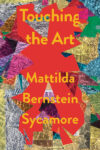
Sharon Mashihi
This essay first appeared in the Full Stop Quarterly, Issue #8. To help us continue to pay our writers, please consider subscribing.
Sharon Mashihi and Aaron Finbloom are part of a team that runs The School of Making Thinking (SMT), an experimental residency program that invites participants to challenge disciplinary conventions of art-making, thinking, and living. Each session, we reinvent our structures and themes.
This session, our theme was “Dialogical Experiments.”
We invited artists who use conversation in their creative practice to create a 30-minute dialogical structure to be enacted 5 times throughout the session. These structures existed alongside creative collaboration, workshops, and opportunities for revision. By signing up for the session, each artist was agreeing to participate in the structures of all the other participants. By the end of the 10 days, we had each participated in 30 structured dialogues. Our goal was to investigate how structure, rules, and iteration can be used creatively to help design innovative conversational content and form. In other words, if a conversation has rules, can it somehow go deeper?
When we were asked to write an article for Full Stop about dialogue, we decided to record ourselves in dialogue about our Dialogical Experiments SMT session. We scheduled our dialogue for the mid-way point in the session, after we had already been through 3 iterations of each participant’s dialogical structure. Before we sat down to talk, we asked each of the participants to provide us with one constraint for our dialogue. We told them the constraints could be anything at all, as long as they were rooted in their practice at SMT. The participants came up with their constraints, and told us we should start by enacting constraints #1 and #2. Constraints #3 and #4 would be added to the conversation at the 20 minute and 40 minute mark respectively, as indicated by our timer.
Constraint #1 – from Liz Rao
To be Applied Throughout: Each time a particular Dialogical Structure project is mentioned it must be attributed to its maker along with a descriptive epithet. Like so: Hayley, full of light. Liz, the most beloved and obedient. Lisa, dark and stormy. Robin, of the wood. Anita, gentle and fierce. Similarly each (and any) time a session participant’s name is mentioned you must include the above epithet.
Constraint #2 – from Anita Olson and Robin Eriksson
To Be Applied Throughout: Once you have enacted a constraint posed by another session participant, take a 5 second pause in silence to reflect. Share your reflections with each other and carry on. Keep in mind that if another constraint is triggered during your 5 second pause, you should follow that constraint and then immediately begin a new 5 second pause and reflection cycle.
Constraint #3 – from Lisa Saban
To Be Added after 20 Minutes: Set a timer for 8 minutes. Keep resetting after it goes off. Every 8 minutes, the first line that comes from each of your mouths must be a rhythm that you must say while holding hands.
Constraint #4 – from Haley Roeser
To Be Added after 40 minutes: Every time you say the word “structure” you need to give the other person a value based complement.
The following is an edited transcript of our dialogue. Throughout the conversation, we reference the projects of the participants of SMT. For a description of each participant’s project, see the appendix at the end of this article.

Aaron Finbloom
Sharon Mashihi and Aaron Finbloom’s Dialogue
Part I
Sharon Mashihi: So we’re here to talk about why it’s worthwhile to structure dialogue. I’ll start by stating one of my beefs of this session: most of the residents aren’t really structuring dialogues. They seem to be creating performative events instead.
Aaron: Haha. I don’t have a clear idea of what we mean when we say “structure.” We never really defined it.
I guess maybe structure is just a stated constraint. So at its very base, when someone says, “Sharon and Aaron, you will talk to each other,” that’s a choice; that’s a stated constraint.
Right. Its explicit.
So I guess I was hoping for more complex structures.
Right. Yeah. There certainly is not a lot of complex structure. And there is certainly not a lot of explicit structure. I think there’s a lot of implicit structures that are in place.
Yes.
People have been choosing the locations for their dialogues. Like the living room vs. the kitchen.
And there have been rules such as, wait your turn to speak, don’t speak at the same time.
Yes, THAT is implicit within all conversations, but here people are all designing certain things and changing conversation in such a way to make it do something. So when Haley full of light decided to have her performance over on the stage in the backyard, wasn’t that something that structured the conversation?
In that case, the constraint was: we have to be on the stage when we have our dialogue. You could argue that when someone is standing on a stage, they are more likely to say certain things, and less likely to say certain other things.
Absolutely!
Yea, but I don’t think that environment and structure are the same thing.
Yeah. Ok, but let’s take Liz, most beloved and obedient’s, project on the first day. She arranged the group into a triangle. And she decided an order in which we could speak, and the constraint was we could only speak in cliches.
That was structured.
That was structured, but it was spatially structured, in terms of how people were organized into a triangle.
There was a spatial structure. Yes. I wouldn’t say that her choice of having us be in the forest was a structure, but I would say that her choice of having us in a triangle was a structure. The reason I considered it a structured dialogue was that there was a very precise set of instructions about who could speak when, and the kinds of things they could and couldn’t say.
Totally. There was an explicit rule of what you could and couldn’t say. And there was an ordering of who could talk at what time. Not many other projects have done that. I think other projects may have implicit structures.
Yes, but when you think about the intention of this session, it’s to be playing with the kinds of choices and constraints that we don’t actively make in regular life. But if I went to a regular old workshop that wasn’t thinking about dialogical structures at all, there might be dialogue, and those dialogues would have implicit structures. But here at the dialogical structured session, it seems like people here are explicit about the content they want to discuss, but not explicit about the structures of the discussions.
Yeah. So I think what structured dialogue is, is an explicit and conscious and conscientious consideration of some number of elements that could be like almost anything. I think it could be place, but it’s a conscious choice of place. I guess it could be one place, but then that’s only one conscious choice you are making.
Yes, exactly. I’m going to do it on the stage because I believe it will affect the content of the dialogue in such and such way.
Yea.
Part II
Let’s go back to our original question: Why structure dialogue? I think it’s because when we study dialogue, we can understand how to communicate more effectively. We can see why some thoughts are successfully communicated and others are not.
[Pause]
Um, I’m very aware that we have eight seconds left and the timer is about to go off. The timer for example, is a structural element that’s affecting the content of our current dialogue.
Absolutely.
[ALARM GOES OFF. WE HAVE HIT THE 20 MINUTE MARK]
Um, so we need to take a five second pause in silence to reflect and then share your reflections with each other. Okay.
[Pause]
Yeah. Well, my first reflection is a question: Are we having the conversation that we intended to have about the purpose of structuring dialogue or are we getting too much into the nitty gritty of our pet peeves about how this session is going?
Yes, I agree. We were getting into the nitty gritty of what structure is, but not talking about the purpose of why we’re doing this.
Ok, I’ll pick the next constraint. It says, “Set a timer for 8 minutes. Keep resetting after it goes off. Every eight minutes, the first line that comes from each of your mouths must be a rhyme that you must say while holding hands.
Great. Okay.
Do you know what my first thought is? These are the exact constraints that I imagined would exist inside people’s Dialogical structures.
Yeah. But I want to play devil’s advocate. I want to defend our residents for not structuring their dialogues in the way we imagined they would. For example, let’s take Liz Most Beloved and Obedient’s triangle structure from the first day. Even though we consider that to be a well executed structure, so what? Like what’s the point? Did that structure do anything good or useful? I don’t think so. Perhaps these types of constraints are just a waste of time.
I disagree. Some constraints are useful. I have received a profound, new and exciting understanding from the development of your structure. That second day when you brought in the transcript of our first session’s conversation, and you had all of these constraints around how we were going to read the transcript and talk about it, I understood how many worlds live inside one conversation. I understood how much just whizzes by in most conversations because they happen so fast and there’s so much I’m thinking about and so much going on. And I so appreciated how the transcript, and the constraints you created, gave me the opportunity to really hear every word and understand every thought.
Yeah. So what does that point to?
It points to elegant design. I was not necessarily interested in the content of your conversation, which was desire and intention. I find that topic boring, uninteresting, and it means nothing to me. And yet, I got a lot out of the dialogue, because it was structured in an exciting way.
On the other hand, there are projects here at this session which are about love and intimacy, which is my favorite subject in the world. But because those conversations have lacked structure, I haven’t gotten anything new out of them. I’m just having conversations I’ve had a million times before.
With the exception of Lisa dark and stormy’s first structure. That dialogue was about love, but it was structured in an innovative way. She found a technique where each of us had to identify with an idea that we disagreed with most. For example, ideas like “love is scary”, and “I am more in love than I have ever been,” and, “Love is a hallmark card.” Then the person who most agreed with the idea, “Love is a hallmark card” had to have a dialogue with the person who most disagreed with “Love is a hallmark card.” That was new. That doesn’t exist in real conversation – an opportunity to identify the idea that you disagreed with most and have a conversation with the person who most agreed with it. It became a very emotional conversation.
And in that conversation, new ground was covered for me. Even though I have spent the last 34 years having conversations ad nauseum about love. So that was extremely successful and something new did come out of it.
Right. So I think that’s a great articulation of a goal. And it’s interesting because this goal you are articulating is a content goal, of coming to new innovative content of conversation.
But the structure allows that new content to emerge.
Yeah, but not all the time. I think people typically don’t think this. People think, “oh, just get someone who knows the content, get an expert on the content and then you just have your content. These scientists have this content you want to talk about, we’ll get them to talk, and now your conversation has the content you need.”
It’s so important to me that conversations be an opportunity to discover new ideas. Experts are the worst in the world at saying new things. They have their script, and they stick to it.
Ok, but structure doesn’t necessarily lead to new conversational content either. Take this conversation we’re having right here. Our residents gave us a number of constraints. But these particular constraints aren’t pushing us to new places, to innovative topics or ideas.
But the structures are adding some levity. Moreover, this first instruction to say the residents’ names in a new way got us in the first place to talk about the residents. So that was a structure that guided the content a bit.
But what’s the groundbreaking new content and conversation you want to get to? Where’s the problem or the new thing you want to get to?
[beep beep beep]
Yes. Can reset it. Don’t forget it.
Where do we want to get to? I wish I had a shoe.
Well at the very least, that made us forget what we were talking about. So we have to recreate something new to talk about. Also, I do think that Anita Gentle and Fierce and Robin of the Wood’s constraint, where we have to give reflection, is potentially changing the content of this conversation because we’re having a moment to reflect on how it’s going so far. Because in everyday conversation people don’t necessarily stop to evaluate at regular intervals. So I would say their constraint has the most potential to affect the content. So I would say their constraint is a good one.
Yeah. So maybe we could ask any of our residents a question “what new kind of content do you want to get to?” And what are some dialogical structures you can use to get there?”
Part III
So I feel like what might be really helpful to do, which we haven’t talked at all about in this session, is to talk about the structure and the constraints themselves and to ask what they’re doing. For example: when you get people to only talk to someone they disagree with, what does that do? Or when you put people in a triangle in the woods, what does that do? We can be making a massive spreadsheet of all our structure components.
And were these questions that came up last year when you did this same kind of session?
No, the main question that came up last session, which isn’t coming up at all here, is the question of meta-structure versus microstructure. So we were talking all about the little structures of the pieces themselves, but not talking at all about how the conversational content is also determined by the macro-structure of the entire session.
Of being at a residency together…
Yes, of being at the residency, where it was very intense, for five days, where everyone’s projects were creating conditions of intimacy.
Yeah. That’s an interesting question. But for me our question of the intentionality of structural choices and their various effectiveness at meeting the facilitators’ goals is a more charged question.
Hmm. Yeah. My immediate question that sort of I’m drawing from both of these is I’m thinking about like how much we can take these structures and put them in another environment. Because if a 30 minute structure is actually conditioned by the eight day structure, then all this research you’re doing into your 30 minute structure is for naught, because as soon as you take any of the resident’s structures and put them somewhere else, they are going to change drastically.
[beep beep beep]
Well, I would say
that on the first day,
the structure that lisa dark and stormy made
could in other places be successfully played.
And I am not so sure about that.
But about why and where
I can’t figure that out.
Well, let me draw a scenario. Imagine that Lisa dark and stormy is invited to a couples retreat in Vermont that’s being run by some famous therapist.
[Alarm]
[5 seconds reflection]
Should we open the next one?
Yeah
“Every time you say the word structure, you need to give the other person a value based complement.” What’s a value based complement? Like “I think you’re beautiful”?
I have no idea what a value based complement is.
Let’s just give each other compliments. So can I get back to my example? So let’s say that lisa dark and stormy was invited to this retreat in order to help couples or grieving families connect better to love. I could very easily….
..see her taking the exact same structure? I love the way that you’re holding your hand.
Thank you. Yes, and make it work there. Or I could similarly see her taking this into a high school that was having a radical health class, and she could come into the room one session and she would have an impact.
I kind of agree. I think that the techniques can migrate. They can go to all dIfferent places and still be very powerful. But I do think that there’s so much that comes before the technique itself that conditions the outcome. So yes, I do think that making a chart of different techniques could be effective. But I’m just saying that the surrounding micro-techniques, and all the context around it, has an effect, right?
Yeah. But I would say, not a huge effect. Saying that the residency puts us in a particular mood that makes us react to the structures (I love your hair) in a particular way, that’s like saying if you go to the movies, when you’re in a good mood, you’re more likely to enjoy the movie. Or if you meet someone on a gorgeous summer night, you’re more likely to fall in love with them. That’s true. But the movie is the movie and the person is the person. I really actually think there’s something extremely valuable about thinking about techniques to find active potent disagreements as quickly and efficiently as possible and then having people discuss those disagreements. That, I think is genius, and I think I’m going to take it with me and I do think it’s a standalone element.
For me, the technique is a seed, you can’t just place a seed anywhere and it’s going to grow, you need in a certain kind of condition.
Yeah, it’s true. I mean, for example, in these conditions, we’re much more likely to be honest and open with each other, because there’s a lot of trust. If Lisa dark and stormy were to take her structure, (I have always found you to be profound) into a high school, maybe the kids in that high school wouldn’t be as prepared to go as as deep as we are here at the residency. But that to me is a small matter. It doesn’t change the fact that the technique we’re describing has potency.
Yeah. Maybe it’s a small point I’m arguing, but I think the set up for the technique matters a lot.
[beep beep]
I agree with you fin,
but I must begin
to urge you
to help me
change the subject
as a we
because I’m tired of arguing this particular myered minutia.
This minutia is something I did pick
and the pain of it. It’s something I continue to inflict
and with it I too. I’m growing sick.
[Laughter]
Yeah. So maybe we can change the subject?
Part IV
I think we started to touch on it, but I’m not sure if we have really defined yet why what we are doing is important. Maybe that’s something we could talk about.
Yeah, let’s talk about that.
Because I mean, what do people think an important conversation is? I’d say some examples would be: a political conversation that gets people to not vote for Trump, or a conversation in a court of law that makes those who are innocent not be found guilty, a conversation that heals your psyche. So why frolic in experimentation when you can just take something directly that you know needs to be changed and have those conversations that are really needed?
Well, I’m just wondering if some of the discoveries that we make in a session like this can be applicable to those kinds of conversations and many others. And I know that I keep coming back to this one revelation from Lisa dark and stormy’s, but I think that’s a perfect example. So let’s say there are two factions and it’s some negotiator’s job to bring these factions to the table. A technique, like the one discovered here, can be used to efficiently spark productive dialogue in such a setting. And if no one ever did things like this experimental dialogues session, if no one ever experimented with what happens if x, y, or z, then we would be limited to our habitual patterns and conversations that don’t always lead to positive results.
Yeah, totally. But one critique is “well, but Lisa dark and stormy is never going to actually do that. She’s never going to be the negotiator bringing two factions to the table.” So wouldn’t it be better for at least Lisa dark and stormy or all of us to just like go to the places that need these kinds of conversations to happen and then do the experimenting there?
I think this is a better place to fail, be nurtured, get the critical feedback of our peers, get to think in a different way. And maybe one of those residents takes something that they’ve learned and either writes a paper about it or includes it in a play and whoever witnesses that will learn and the number of witnesses will multiply. In fact, this residency seems so much more obviously relevant to the problems of the world than a poetry artist residency. Which is not to say that I’m against a poetry artist residency, I think that’s important too. But the discoveries here can affect divorce negotiations and United Nations conflicts and so many very obviously agreed upon important elements of being part of a world culture.
[Pause]
Ok. Yea so one other thing that I wanted to think about is the idea of facilitation. And this relates totally to Anita gentle and fierce and Robin of the woods’ project. Because I think the idea of facilitation is that you can’t pre-structure anything because anything that you structure, any technique that you bring, might not be placed at the right moment. Because if you structure (that sweater is really great) if you create that sense of sequencing in advance, that might not be what the conversation is asking for. So the idea of facilitation goes against a lot of what we’re talking about here. It might be something interesting to bring up. A good facilitator is perhaps better than any technique.
Are you also saying that a good facilitator, if given the exact structure (you were born to run SMT) that I designed yesterday, they would have been able to get better results than I did?
Maybe yes. But here’s one argument against facilitation. Facilitation moves through all the techniques and rules and all these things so quickly that we can’t even see what’s happening. Also, it does so by having a singular person in charge of the movement of that thing. So I think by creating these dialogical structures (I think you’ve been amazing in this conversation, I’m so in awe) so by creating those, I think what we do is we move away from having a person be in charge of the movement and we focus on the actual things that are happening in the conversation that are moving too fast for us to even see and we create something that can persist. That’s the thing which I’m excited about. We can make something that we can take and repeat and repeat and repeat.
Yes, I agree!
[TIMER]
This is so annoying.
I am not enjoying
this prompt.
I think if you just had a little more light,
you would learn to not make it such a fight.
So in that sense, any one of us could ideally be able to write up one of our structures (and your eyes are so beautiful) and anyone else could repeat it. So that people wouldn’t be dependent on the skill of the facilitator. They could simply rely on the structure.
Exactly. There’s a certain kind of greater ethical claim that’s being made. There is a certain hierarchy that says, “we need a good facilitator to do this thing,” but creating a structure (you’re one of my best friends) that can be repeated, takes away that need. It’s even more democratic, in that anyone can do it.
I love that.
Yup. Anyway, time’s up.
Ok, bye.
Bye, see you.
“DIALOGICAL EXPERIMENTS” SESSION PARTICIPANTS
Anita Olson and Robin Eriksson
Anita and Robin practiced arts-based facilitation to get at what they described as “the heart” of the group. In each of their sessions, they asked us to try a series of exercises primarily drawn from Augusto Boal and other impulse-based exercises. One example was an exercise where we had to simultaneously draw a cross with one hand, and a circle with the other hand. This challenging physical procedure was then used in a following session as the group attempted to conceptualize and embody the “cross” and the “circle” using mapping and physical theatre exercises.
Sharon Mashihi
Sharon created dialogical structures that aimed to instigate never-before-had conversations about self-hatred, negative inner dialogue, and habits of thought. During one session, participants created moment-by-moment snapshots of self-critical thinking they had engaged in in the past few hours. This list was then discussed using focused dialogical prompts.
Aaron Finbloom
Through the use of conversational games, prompts, and rules, Aaron explored the un-spoken possibilities in moments of conversation. Aaron created a verbatim transcription of a conversation which occurred on the first day. This transcription was then read aloud by the exact same participants, creating an eerie replay of a conversation. The re-reading also created brief opportunities for participants to stray from the script and offer new interpretations and insights.
Liz Rao
In each of her Dialogical Structures, Liz tried to work out an artistic process hang up, while at the same time proving or disproving something about group dynamics and language. Most hang-ups were issues she encountered as a filmmaker, such as: the fear of being boring, and the desire to instigate conflict. In one example of dialogue, Liz arranged the group into a triangle formation as we were walking through the woods. She assigned the group members an order in which we could speak, and instructed us to only speak in cliches.
Haley Roeser
Haley’s Dialogical Structures drew on her interests in sensual mapping, walking, love, and sex. For example, she had participants integrate tinder swipes into conversations on love, curate make-believe galleries, and walk in small groups while noticing, describing, and reflecting on what we were sensing in our immediate surroundings.
Lisa Saban
Lisa explored tension in two-person theatrical dialogues. In each of her structures, she identified topics for tense dialogue and observed what happened when two people were asked to engage in those dialogues. In one example, she made a script out of a moment of tension between two members of the group. This script was then used to improvise and direct a series of theatrical scenes based on this encounter.
This post may contain affiliate links.







